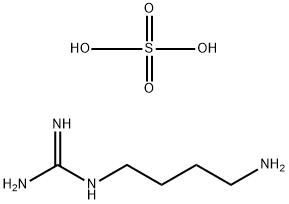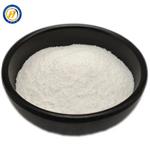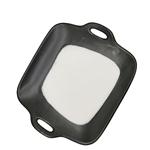General Uses
Neuroprotective, CNS studies, Autism and depression research
Description: Agmatine Sulfate is a polyamine derived from L-arginine decarboxylation and is a known putative endogenous neurotransmitter at imidazoline receptors. Agmatine sulfate displaces clonidine at α2-adrenergic and at imidazoline receptors and was recently shown to exert some neuroprotective effects. It blocks NMDA-receptor associated cation channels. Acts as a competitive inhibitor of nitric oxide synthase (NOS). It functions as neurotransmitter since it is stored in synaptic vesicles and is related from axon terminals by depolarization(1). Protects autistic behavior in rats and reverses depressive like behavior in mice.
Description
Agmatine sulfate is the sulfate of the Agmatine. Agmatine is an aninoguanidine that is naturally derived from the arginine. It can exert modulatory effect on many molecular targets such as neurotransmitter systems, opioid analgesia, ion channels, and nitric oxide (NO) synthesis and polyamine metabolism. It has been also found that it can reverse the pain induced from inflammation, neuropathy, and spinal cord injury. Those effects make it a potential candidate for multiple pharmacological applications in the future.
Chemical Properties
White to off-white powder
Uses
Agmatine is an intermediate in the biosynthesis of the polyamines putrescine and spermine. Agmatine binds with high affinity to α2-adrenergic receptors and imidazoline binding sites and produces blockade of the NMDA-receptor associated cation channels. Agmatine is a competitive inhibitor of nitric oxide synthase activity owing to mimicry of the natural NOS substrate arginine.
Uses
Agmatine Sulfate is a a polyamine derived from L-arginine (A769500) decarboxylation and is a known putative endogenous neurotransmitter at imidazoline receptors. Agmatine sulfate displaces clonidine a
t α2-adrenergic and at imidazoline receptors and was recently shown to exert some neuroprotective effects.
Biological Activity
Arginine metabolite that is synthesized within bovine brain and exhibits clonidine-displacing substance (CDS) activity. Putative endogenous ligand for the imidazoline binding site.
Biochem/physiol Actions
Putative endogenous neurotransmitter at imidazoline receptors; displaces clonidine at α2-adrenergic and at imidazoline receptors; blocks NMDA-activated ion channels in hippocampal neurons.
Purification Methods
Crystallise the salt from aqueous MeOH. The free base has m 101.5-103o, the gold chloride hydrochloride crystallises from H2O with m 223o(dec), and the picrate has m 236-238o. [Odo J Chem Soc Jpn 67 132 1946, Beilstein 4 I 420, 4 II 703, 4 III 575, 4 IV 1291.]
References
Fairbanks, C. A., et al. "Agmatine reverses pain induced by inflammation, neuropathy, and spinal cord injury." Proceedings of the National Academy of Sciences of the United States of America97.19(2000):10584.
Kolesnikov, Yuri, S. Jain, and G. W. Pasternak. "Modulation of opioid analgesia by agmatine." European Journal of Pharmacology296.1(1996):17-22.
Su, R. B., J. Li, and B. Y. Qin. "A biphasic opioid function modulator: agmatine. "Acta Pharmacologica Sinica24.7(2003):631.
Galea, Elena, et al. "Inhibition of mammalian nitric oxide synthases by agmatine, an endogenous polyamine formed by decarboxylation of arginine." Biochemical Journal 316 ( Pt 1).1(1996):247.
https://en.wikipedia.org/wiki/Agmatine




